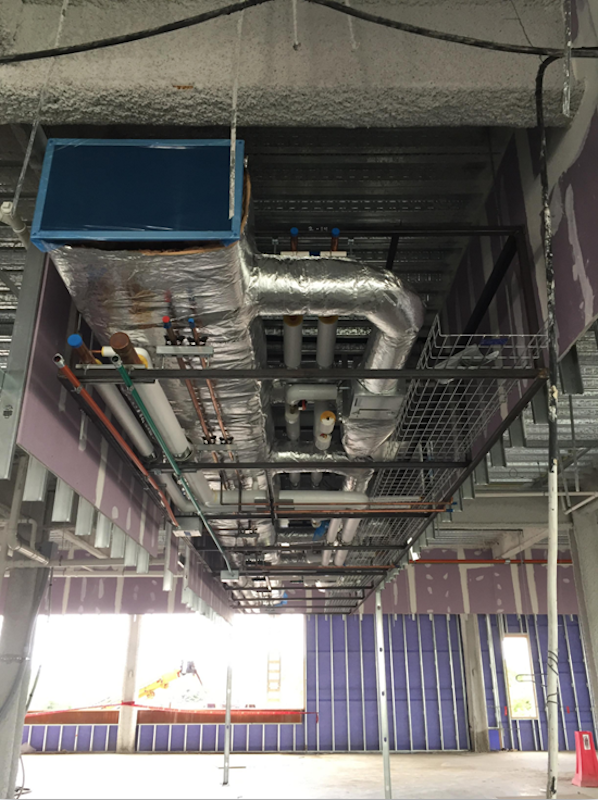Trade partners are still the odd men out during the early stages of many projects, which can make conflicts, change orders, and delays during construction more likely.
To avoid potential snafus on its new Ambulatory Health Center in Greenfield, Wis., Advocate Aurora Health and the real estate developer Cobalt Partners formed an integrated project team with the general contractor CG Schmidt, the national design firm HGA Architects and Engineers, the mechanical contractor J.F. Ahern, and the commercial electrician Staff Electric, the latter two under a Trade Management Partners (TMP) agreement.
“Advocate Aurora Health is leading the industry in integrated project delivery,” says Cory Powers, CPD, Principal and Project Manager for HGA’s energy and infrastructure group.
TMP exemplifies collaboration. Through this arrangement, skilled contractors and supplies can engage early in the project and its design process, which helps reduce redundancies, address challenges that relate to cost and constructability, and come up with more efficient solutions.
The client’s key goal for this five-story 146,200-sf project, located in the 40-acre 84South mixed-use development, was speed to market so it could start seeing patients as soon as possible. That objective led the team to focus on using Lean Construction Methods to accelerate the project’s schedule.
PUSHING THE ENVELOPE ON PREFAB

Two-fifths of the work within 80 MEP racks were prefabricated.
To this end, the project pushed the limits of prefabrication through the use of 80 multi-trade prefab MEP racks that included long sections of duct work in the corridors.
Forty percent of the above-ceiling MEP work was prefabricated off-site. The construction was completed in 18 months, which gave the community local access to healthcare one month earlier compared to a traditional delivery method. Zero percent rework was achieved versus 15% rework in traditional delivery methods. And there were no injuries building and installing the MEP racks.
The team members worked in tandem from a single 3D BIM model, eliminating miscommunication and the need for re-drawings. And to reduce the risk of design errors, the team relied on state-of-the-art fabrication software, with each component barcoded and shipped to the jobsite along with an installation plan.
Using their mobile devices, workers scanned the barcodes to verify the location for each installation. Once on site and verified, the prefabricated racks were lifted to each floor to be connected and attached, a task completed within an hour of each delivery.
Powers of HGA says that prefabrication emerged as a solution during the team’s early design discussions. And the building’s systems “were laid out to be modular.” Powers adds that prefab is playing an even more prominent role in the design and construction of Advocate Aurora Health’s next two hospitals that will include bathrooms and exam rooms assembled off site.
The completed Ambulatory Health Center, which opened August 5, is valued at $55.5 million. The building is the central location for Advocate Aurora Children’s Health services that include pediatric cardiology, urology, allergy, dermatology, ENT, neuropsychology, and radiology. It has eight surgical suites, two pain management procedure rooms, four GI suites and two outpatient interventional radiology suites that are the first of their kind in Wisconsin.
With the Health Center’s recent opening, Advocate Aurora Children’s Health can offer more comprehensive pediatric services to the area. The facility also houses Advocate Aurora’s Sports Health services, along with a pediatric sports health gym and classroom space. This space brings increased availability for outpatient orthopedic surgery to patients.
The Health Center is home to midwifery services with a variety of women’s health services provided, ranging from general health education to family planning and obstetric care. Its outpatient center co-locates orthopedic exam, office, and imaging conveniently at the retail-inspired main entry, with surgical, recovery, and pain management services on floors above.
IPD ‘THE PATH FORWARD’
“This 84South facility is actually one of the very largest outpatient ambulatory sites in all of our Wisconsin and Illinois footprint, and it will enable us to open up access for the people of the broader Greenfield community,” said Advocate Aurora Health's COO Bill Santulli, in an interview with the Milwaukee Business Journal.
When asked why integrated project delivery isn’t more common, Powers says that each AEC firm and owner is at different stages of its Lean journey. “You can’t fake experience in an IPD.” Too many firms and owners “are stuck in delivery methods that are based on fear” that they wouldn’t get the same value from an IPD contract.
“But once you go through one of these, there’s nothing else like them,” says Powers. “We can go pretty fast on our own. But it’s so much faster when you don’t have to explain everything in the field. The team comes out of the gate drumming the same beat when you’ve worked out the details months before the first dirt is broken.”
Mark Lillesand, a Vice President with CG Schmidt, thinks that integrated project design will become more prevalent as more owners become familiar with its benefits, which include “furthering our relationships with subcontractors.”
Lillesand says his firm now “prefabricates everything we can” especially now when the coronavirus has raised the stakes for jobsite safety. He adds that on other projects, CG Schmidt has included subs for drywall, steel construction, and enclosures into the early design discussions. “This is the path forward for us.”
Related Stories
| Aug 11, 2010
Loft Condo Conversion That's Outside the Box
Few people would have taken a look at a century-old cigar box factory with crumbling masonry and rotted wood beams and envisioned stylish loft condos, but Miles Development Partners did just that. And they made that vision a reality at Box Factory Lofts in historic Ybor City, Fla. Once the largest cigar box plant in the world, the Tampa Box Company produced boxes of many shapes and sizes, spec...
| Aug 11, 2010
Idea Center at Playhouse Square: A better idea
Through a unique partnership between a public media organization and a performing arts/education entity, a historic building in the heart of downtown Cleveland has been renovated as a model of sustainability and architectural innovation. Playhouse Square, which had been working for more than 30 years to revitalize the city's arts district, teamed up with ideastream, a newly formed media group t...
| Aug 11, 2010
Pioneer Courthouse: Shaking up the court
In the days when three-quarters of America was a wild, lawless no-man's land, Pioneer Courthouse in Portland, Ore., stood out as a symbol of justice and national unity. The oldest surviving federal structure in the Pacific Northwest and the second-oldest courthouse west of the Mississippi, Pioneer Courthouse was designed in 1875 by Alfred Mullett, the Supervising Architect of the Treasury.
| Aug 11, 2010
Divine intervention
Designed by H. H. Richardson in the 1870s to serve the city's burgeoning Back Bay neighborhood, Trinity Church in the City of Boston would come to represent the essence of the Richardsonian Romanesque style, with its clay tile roof, abundant use of polychromy, rough-faced stone, heavy arches, and massive size.
| Aug 11, 2010
Westin Hotel
Mid-twentieth-century projects are in a state of limbo. In many cities, safeguards against quick demolition don't even cover “new” buildings built after 1939, yet many such buildings may be obsolete by current standards. The Farmers and Mechanics Savings Bank, located in downtown Minneapolis, was one such building, a rare example of architecture from a time when American design was ...
| Aug 11, 2010
Dream Fields, Lone Star Style
How important are athletic programs to U.S. school districts? Here's one leading indicator: In 2005, the National Football League sold 17 million tickets. That same year, America's high schools sold an estimated 225 million tickets to football games, according to the American Football Coaches Association.
| Aug 11, 2010
Platinum Award: Monumentally Hip Hotel Conversion
At one time the tallest building west of the Mississippi, the Foshay Tower has stood proudly on the Minneapolis skyline since 1929. Built by Wilbur Foshay as a tribute to the Washington Monument, the 30-story obelisk served as an office building—and cultural icon—for more than 70 years before the Ryan Companies and co-developer RWB Holdings partnered with Starwood Hotels & Resor...
| Aug 11, 2010
Living and Learning Center, Massachusetts College of Pharmacy & Health Sciences
From its humble beginnings as a tiny pharmaceutical college founded by 14 Boston pharmacists, the Massachusetts College of Pharmacy & Health Sciences has grown to become the largest school of its kind in the U.S. For more than 175 years, MCPHS operated solely in Boston, on a quaint, 2,500-student campus in the heart of the city's famed Longwood Medical and Academic Area.
| Aug 11, 2010
Gold Award: Eisenhower Theater, Washington, D.C.
The Eisenhower Theater in the John F. Kennedy Center for the Performing Arts in Washington, D.C., opened in 1971. By the turn of the century, after three-plus decades of heavy use, the 1,142-seat box-within-a-box playhouse on the Potomac was starting to show its age. Poor lighting and tired, worn finishes created a gloomy atmosphere.
| Aug 11, 2010
Giants 300 University Report
University construction spending is 13% higher than a year ago—mostly for residence halls and infrastructure on public campuses—and is expected to slip less than 5% over the next two years. However, the value of starts dropped about 10% in recent months and will not return to the 2007–08 peak for about two years.







